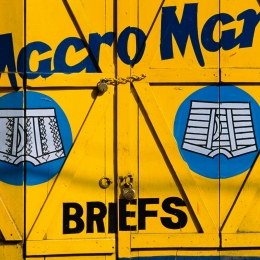art or business
Csilla Babinszky: Are you an optimist?
The photos taken in the various cities of India depict "graffiti" wall details and paintings that can be seen in public squares, buildings and cars. Advertisements, trade-signs, logos, painted pictures of car registration plates.
Instead of neon advertisements, various products and services are put on offer with the help of paintings, such as the Macro Man promoting a place selling sporty swimwear or a teacup painted on the wall indicating a teahouse near by.
The primary interest of Babinszky, however, is not in the visual manifestations of advertisements or unique advertising surfaces. To her, of much greater importance are the drawings "discovered" during her walks, which are colourful and two-dimensional with a unique interpretation of the rules of perspective, and whose feeble-minded naivety brings a smile to the spectator's face. As evident from the cutouts and the composition of the photos, the point here is not the location of the images but the images themselves and the messages they convey.
In conjunction with her earlier exhibitions, Csilla Babinszky writes about the works - one of which entitled Still-Life (Csend-Élet) can be seen at the current kArton Gallery exhibition - that, at first glance, appear to be articles of commodity (TV, audio tape player), creating a realistic notion of the object. The objects, however, have lost their original function, "they are products of real craftwork, eliminating all mechanic devices. Still this is not some personal interpretation of the theme. Its gesture is based on the childhood experience of "the magic pencil, in which drawn things come to life, and the concepts - the imagination - manifest as real toys. It is these objects that I paint in their original size, trying with the greatest humility possible to follow their unique characteristics of form. My point of departure is reality. At the same time, their validity of statement is gained by virtue of their "uselessness."
Looking at the photos of images, one gets the sense that the drawings are just about to come to life, as if the colourful contours and the homogeneous coloured surfaces between them were just about to become real.
The second part of the exhibition is comprised of the artist's latest paintings. On the images, the decorative tablecloth and the fragments of white cutlery are dominated by round forms composed onto different layers. The choice of form is not an accident. These works are meditational maps of sorts, everyday shapes of the symbol of wholeness. Wholeness and optimism are closely related concepts.
Are you an optimist? This is the title of Csilla Babinszky's exhibition at the kArton Gallery. The paintings and the photos give expression to the artist's affirmative answer.

